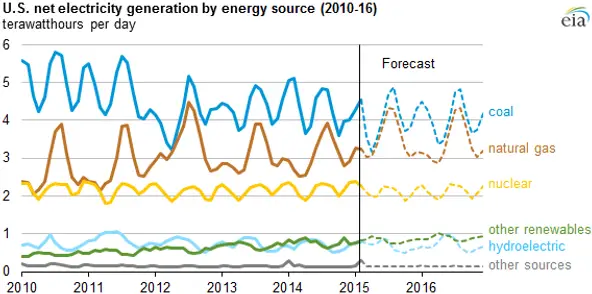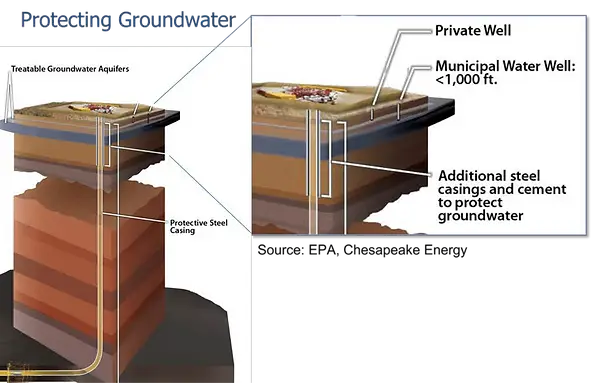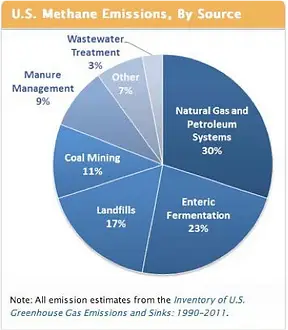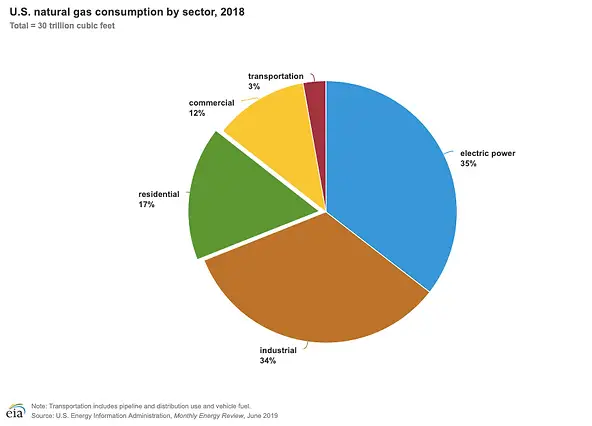To my readers, the information henceforth is compiled from the resources mentioned in this article including Daniel Brock’s “An Ethical Look at Hydraulic Fracturing” 2014, John Whibey’s “Pros and cons of fracking: 5 key issues” 2015 from the Yale Climate Connections and all the smart people that contributed to the 2014 review, “The Environment Costs and Benefits of Fracking.”
I also include small bits of commentary from myself.
The Short-Short History of Fracking
Modern day hydraulic fracturing for oil and gas has been around since the 1940’s when the first experiment involving “fracking” occurred in Kansas in 1947 when 1,000 gallons of gelled gasoline and sand were injected into a gas-producing limestone at 2,400 feet. Although this experiment did not produce exceptional results, nonetheless the research on fracking continued along with more experiments from Halliburton in 1949 that actually did create successful results.
With that in mind, there are valid concerns in social and environmental groups and the general public regarding personal health and safety, long-term climate and environmental impacts, economic and energy (in)dependence factors, and industry accountability, to name a few. In this article, I deliver you done some diligent research from university whitepapers, environmental literature reviews, and industry regulatory information along with my own insight from personal experiences as a Field and In-House Landman. In addition, to the best of my ability I looked to provide the fairest information I could find to present you with an unbiased narrative. The information supplied herein that is not my own has been cited and references are provided at the conclusion of this blog to their respective websites.
So, let’s dig in! (Pun totally intended btw..)
What People Argue About When it Comes to Fracking
The main arguments surrounding fracking are:
· Air quality & water contamination
· Greenhouse gas leaks & climate change
· Local infrastructure and community impacts
· Geological changes in the earth’s crust potentially leading to earthquakes
If we’re going to look at both sides, we also have to take into account:
· America’s energy needs
· The economic benefits
· The political leverage and potentials
For this to be a comprehensive, “parts-make-up-the-whole” article, we address these bullet points singularly and collectively.
First, it makes sense to look at our needs for energy in the first place.
Hey! Who turned the lights off?
In Daniel Brock’s research paper, An Ethical Look at Hydraulic Fracturing (Southern Methodist University 2014), he references ExxonMobil’s 2014 Energy Outlook in which he provides the following information that “they predict the world will expect to see:
- 2 billion more people
- A 130% larger global economy
- About 35% greater demand for energy (doubled without efficiency gains)
- About 60% of demand supplied by oil and natural gas
- Natural gas will surpass coal as the second-largest source of energy
- 90% growth in demand for electricity”
All too often nowadays there is a report in the news about increasing population and economy growth and people living longer so there is no doubt we will need this energy! And how can we live without it? It shudders me to think about how our ancestors lived with no electricity, a/c and heat, cars for every individual or worse, a smartphone! Columbia University’s Center of Global Energy Policy says, “Energy is a necessary input to improving quality of life and economic growth. Access to reliable and affordable energy sources can reduce poverty, improve public health, and improve living standards in myriad ways.”
I think most everyone can agree we don’t want to go backwards in time and evolution. In fact, I think it’s helpful to educate as many people as we can on the benefits of natural gas and oil and how it’s used in our everyday lives that most people don’t know about.
The Benefits of Natural Gas (Brock 2014)
1. It’s ABUNDANT: A 70-100 year supply and growing
2. It’s CLEAN: Lowest amount of carbon emissions than coal and oil & basically sulfur free
3. It’s DOMESTIC: Produced in 32 states, used nationwide; N. America supplies the US with 98% of its natural gas needs
4. It’s VERSATILE: Electricity generation for home, business and transportation
5. It’s SECURE: Does not require importation from foreign countries and distribution systems are already in place
6. It’s VALUABLE: The oil & gas industry supports 9.2 million U.S. jobs
7. It’s GEOPOLITICAL: May be used for internal bargaining power and trade and it can be exported as a major source of revenue
The fact is, as of right now natural gas is the only hydrocarbon alternative we have. We have enough of it to fulfill the energy demands our world requires. Coal is too expensive with damaging effects to climate change, nuclear too expensive and volatile and we just aren’t there yet with green energy sources.
Think of Natural Gas as a Bridge
To get to the next era of green energy there has to be steps involved to get there. After all, we didn’t go straight into smartphones, did we? We started out with Morse-code telegraphs to operator-assisted telephones to the handset with the ability to make local calls to long distance then to transatlantic with the help of satellites then to fiber optics to where we are at today with advances in micro-electronic technology to enable almost everyone today to have a mobile phone. And all this took place within a span of 145 years! Of course, nowadays advances in almost anything including technology, healthcare, mechanics, travel, etc. takes far less time than it did before, but it still takes time.
Just like the landline phone was a bridge to the smartphone, so is natural gas to a more eco-friendly, sustainable, renewable energy source. If you’re a numbers person, it’s only been 72 years since the first time fracking was ever attempted in a modern-day way. Look at how far we’ve come in half the time it took for the telephone to mature! With the advances in fracking technology, land and geologic engineering, industry responsibility and awareness and not to mention, how the abundance of this commodity is important for us economically and on a geopolitical scale, we must be patient and open-minded regarding the evolution of fracking.
So for now, we have natural gas (and lots of it!) and the only way we know how to get it is through hydraulic fracturing. And no matter the industry or new technology, there will ALWAYS be issues – safety, health, etc. at the start. Think of all the health and safety risks coal miners faced and in many cases, lost their lives. Or what about those involved in space travel and exploration? There will always be consequences early on until the knowledge, technology, and processes get better and more refined.
Concern #1: Air Quality & Water Contamination
CON FRACKING: First, it is not the case that a new natural gas facility coming online always replaces a legacy coal-fired power plant. It may displace coal in West Virginia or North Carolina, but less so in Texas and across the West. Second, air quality dynamics around fracking operations are not fully understood, and cumulative health impacts of fracking for nearby residents and workers remain largely unknown. Some of the available research evidence from places such as Utah and Colorado suggests there may be under-appreciated problems with air quality, particularly relating to ozone. Further, natural gas is not a purely clean and renewable source of energy, and so its benefits are only relative. It is not the answer to truly cleaning up our air, and in fact could give pause to a much-needed and well thought-out transition to wind, solar, geothermal, and other sources that produce fewer or no harmful airborne fine particulates. (Whibey 2015)
PRO FRACKING: Increasing reliance on natural gas, rather than coal, is indisputably creating widespread public health benefits, as the burning of natural gas produces fewer harmful particles in the air. The major new supply of natural gas produced through fracking is displacing the burning of coal, which each year contributes to the early death of thousands of people. Coal made up about 50 percent of U.S. electricity generation in 2008, 37 percent by 2012; meanwhile, natural gas went from about 20 percent to about 30 percent during that same period. In particular, nitrogen oxide and sulfur dioxide emissions have been reduced dramatically. Fracking saves lives, and it saves them right now and not at some indiscernible date well into the future. (Whibey 2015)

Water Contamination
CON FRACKING: Fracing fluid, which contains over 700 chemicals, is believed to cause cancer, kill animals and taint clean drinking water sources. On average, 99.51% of hydraulic fracturing fluids are comprised of freshwater and sand. Reports continue to pile up in Pennsylvania of landowners who claim their drinking water has been contaminated due to improper well casing or waste disposal negligence. Another concern among residents is that oil and gas companies refuse to disclose what chemicals are in the fracing fluid, because of a loophole put into the Safe Drinking Water Act in 2005. Critics argue that nobody knows how the enclosed fluid will behave and long-term risks are unforeseeable and require more in depth research before conducting more hydraulic fracturing.
PRO FRACKING: The biggest misconception among all the hydraulic fracturing debates is the public’s general lack of knowledge between the different phases of fracing. The actual process of hydraulic fracturing is when air, sand and water is pumped into the ground with high pressure to shatter the shale to release the hydrocarbons.
Depending on the shale, average fracing depth can range anywhere from 5000ft to 10,000ft below the surface. The Marcellus shale averages about 5,000ft below the surface (Explore Shale 2011). These depths are well below the average depth of water aquifers in the United States. Water aquifers tend to be no lower than 1,000ft below the surface. The Marcellus shale’s water aquifer lies about 933ft below the surface (Explore Shale 2011). Therefore, the EPA confidently can confirm there have been no cases of water contamination from the actual hydraulic fracturing process.

However, what the general public fails to realize is that hydraulic fracturing does not pose a risk to groundwater contamination, but improper well casing and surface spills can. Well casing issues have been around since the dawn of the oil and gas industry, but often tend to be extremely rare events. In 2014, the Associated Press completed an investigation on confirmed cases of water contamination from drilling in several states. Based on Pennsylvania’s Department of Environmental Protection data, the AP estimated that “the well failure rate is about one third of one-percent (0.33 percent) of all the oil and gas wells drilled in Pennsylvania since 2005” (Brown 2014). The AP’s findings are right in line with a 2011 report by the Ground Water Protection Council, which found a well failure rate of less than one percent in Ohio and Texas. While a well failure rate of above zero still as room for improvement, numerous states continue to enhance their existing regulations, including those governing well integrity.
Chemical spills on the surface are more likely the culprits for water contamination, but fracing sites are not always the obvious perpetrators. According to a 2009 Congressional Research Service report:
leaky septic system, or improper disposal of domestic refuse such as car batteries or used oil, could leak from the surface into the water well. If this is the case, a dispute could ensue as to who is responsible for contaminating the water well. Resolving the dispute could involve a hydrogeological investigation to prove or disprove any linkage between natural gas development activities and water well contamination, often at considerable expense and with an uncertain outcome, given the complexity of groundwater flow at most sites.
Congressional Research Service 2009
This remains the ongoing dilemma of environmental law and the oil and gas industry. Pinpointing a culprit of groundwater contamination is not an easy task due to the high volume of variables.
Many opponents of fracing fluid often site that companies fail to disclose all the chemicals in the fracing process. That simply isn’t true anymore. Of the hundreds of chemicals in fracing fluid, a limited number of them are routinely used. The FracFocus Chemical Disclosure Registry discloses a list of the chemicals used most without disclosing all the substantial information that could put oil and gas company’s trade secrets at risk (Prewitt and Cisneros 2013). Even though, FracFocus falls short of disclosing all the chemicals, the website at least establishes a middle ground between energy companies’ rights to competitive advantage through trade secrets and a general respect of transparency to the public. (Brock 2014)
Concern #2: Greenhouse Gas Leaks & Climate Effects
CON FRACKING: While carbon dioxide emissions are discussed in the media quite regularly, methane often stays comfortably under the radar unless something happens. Meanwhile, according to the EPA, methane (CH4) is the second most prevalent greenhouse gas emitted in the United States. The vast majority of this gas comes from oil and gas activities. Analysts estimate that the energy sector is responsible for about 30% of global methane emissions, with North America leading the charge.

Research from Cornell has suggested that leaked methane from wells essentially wipes out any greenhouse gas benefits of natural gas derived from fracking. And at other points in the life cycle, namely transmission and distribution, there are further ample leaks. Falling natural gas prices will only encourage more energy use, negating any “cleaner” benefits of gas. Finally, there is no question that the embrace of cheap natural gas will undercut incentives to invest in solar, wind, and other renewables. (Whibey 2015)
PRO FRACKING: We know that at the power plant level, natural gas produces only somewhere between 44 and 50 percent of the greenhouse gas emissions compared with burning of coal. This is known for certain; it’s basic chemistry. That is a gigantic benefit. Further, some research that claims methane is so harmful uses a 20-year time horizon; but over a 100-year time horizon – the way we generally measure global warming potential – methane is not nearly so harmful as claimed. In addition, methane gradually loses its potency as a greenhouse gas over time (Brock 2014). Thus, methane’s impact is potent but relatively brief compared with impacts of increased carbon dioxide emissions. In addition, a new study from nine energy companies that drill for natural gas and several environmental groups, suggest that methane from drilling and fracing does not spew as much gas as expected. Kevin Begos from the Associated Press noted, “The study found that during the process of extracting natural gas from the ground, total leakage at the study sites was 0.42 percent of all produced gas.” The results were published by the Proceedings of the National Academy of Sciences. (Begos 2013)
The number-one priority must be to reduce the reliance on coal, the biggest threat to the atmosphere right now. Fears about emissions leaks are overblown. Even if the true leakage rate were slightly more than EPA and some states estimate, it is not that dramatic. We are developing technology to reduce these leaks and further narrow the gap. Moreover, research-based modeling suggests that even if energy consumption increases overall, the United States still will reap greenhouse benefits as a result of fracking. (Whibey 2015)
Concern #3: Local Infrastructure and Community Impacts
CON FRACKING: More than 15 million Americans have had a fracking operation within a mile of their home. Still, that means that a small proportion of people shoulder the burden and downsides, with no real compensation for this intrusive new industrial presence. Fracking is hugely water-intensive: A well can require anywhere from two- to 20-million gallons of water, with another 25 percent used for operations such as drilling and extraction. It can impact local water sources. The big, heavy trucks beat up our roads over hundreds of trips back-and-forth – with well-documented consequences for local budgets and infrastructure. In places such as Pennsylvania, Ohio, and Colorado, the drilling rigs have popped up near where people have their homes, diminishing the quality of life and creating an industrial feel to some of our communities. This is poor planning at best, and sheer greed at its worst. It seldom involves the preferences of the local residents.
Finally, it’s also the case that relatively low impact fees are being charged and relatively little funding is being set aside to mitigate future problems as wells age and further clean-up is necessary. It is the opposite of a sustainable solution; as well production tends to drop sharply after initial fracking. Within just five years, wells may produce just 10 percent of what they did in the first month of operation. In short order, we’re likely to have tens of thousands of sealed and abandoned wells all over the U.S. landscape, many of which will need to be monitored, reinforced, and maintained.
PRO FRACKING: Water intensity is lower for fracking than other fossil fuels and nuclear: Coal, nuclear and oil extraction use approximately two, three, and 10 times, respectively, as much water as fracking per energy unit, and corn ethanol may use 1,000 times more if the plants are irrigated. For communities, the optics, aesthetics, and quality of life issues are real, but it’s worth remembering that drilling operations and rigs don’t go on forever – it’s not like putting up a permanent heavy manufacturing facility. The operations are targeted and finite, and the productivity of wells is steadily rising, getting more value during operations. Moreover, the overall societal benefits outweigh the downsides, which are largely subjective in this respect.
A 2016 article from the Energy Policy Institute at the University of Chicago (EPIC) denotes:
In studying the economic impacts, author Michael Greenstone from the University of Chicago and his co-authors take into account local changes in amenities, including determinants of quality of life like truck traffic, criminal activity, noise and air pollution from drilling activity, and beliefs regarding negative health effects. They found these costs are outweighed by the benefits, which total $1,200 to $1,900 per year for the average household.
The benefits include a 6 percent increase in average income, driven by rises in wages and royalty payments, a 10 percent increase in employment, and a 6 percent increase in housing prices. On the costs side, fracking reduces the typical household’s quality of life by about $1,000 to $1,600 annually—excluding the increase in household income.
These costs and benefits are based on the present knowledge at the time, says Greenstone, the Milton Friedman Professor of Economics and director of the Energy Policy Institute at the University of Chicago: “Our estimates are based on the knowledge that communities currently have. So, for example, if new information emerges that indicates that there are larger negative, local health effects than is currently believed, this would likely lead to declines in housing prices and the overall welfare impacts. But based on what is currently known, the average community that has allowed fracking has enjoyed substantial net benefits.”
In a recent article published on oilprice.com on December 2019:
Baker Hughes has vowed to generate 100 percent of the energy it uses in Texas from solar and wind power capacity, Bloomberg reports, citing a statement by the company. According to Baker Hughes, switching to solar and wind to power its 170 facilities across the Lone Star State will reduce its global carbon footprint by 12 percent.
The move is part of Baker Hughes’ plan to become a net zero emitter by 2050. The plan was announced at the company’s annual meeting in January this year. Baker Hughes said it would aim to reduce its carbon dioxide emissions by half by 2030 and to zero over the next two decades.
At the time, Baker Hughes boasted that it had already managed to reduce its carbon dioxide emissions by 26 percent since 2012 by utilizing new technology and operational efficiencies”.
“Oil and gas will continue to be an important part of the global energy mix, and BHGE is committed to investing in smarter technologies to advance the energy industry for the long-term,” Baker Hughes’ chairman and chief executive Lorenzo Simonelli said at the meeting. “Managing carbon emissions is an important strategic focus for our business. We believe we have an important role to play as an industry leader and partner,
Concern #4: Increased Seismic Activity
CON FRACKING: We are only just beginning to understand what we are doing to our local geologies. The 2014 Annual Reviews of Environment and Resources paper notes that “between 1967 and 2000, geologists observed a steady background rate of 21 earthquakes of 3.0 Mw or greater in the central United States per year. Starting in 2001, when shale gas and other unconventional energy sources began to grow, the rate rose steadily to [approximately] 100 such earthquakes annually, with 188 in 2011 alone.” New research on seismology in places such as Texas and Oklahoma suggests risky and unknown changes. It is just not smart policy to go headlong first – at massive scale – and only later discover the consequences. (Whibey 2015)
According to Oklahoma seismic data, less than four months into 2014, the state has recorded 253 such tremors (matching all of Oklahoma’s seismic activity in 2013), and the finger is being pointed at Oklahoma’s fracing industry (Gilliam 2014).
Earthquakes about 2.5 magnitudes or above are strong enough to rattle items on a shelf. Not only is Oklahoma now the 2nd most seismically active state, but also it is the center of the United States hydrocarbon industry. Noticeably, Oklahoma houses more than 10,000 wastewater wells (second to Texas in housing the most class II injection wells), triggering red flags to geologist (EPA 2011). (Whibey 2015)
To understand the increased seismic activity’s connection to fracing, one must differentiate between the processes of fracturing shale rock versus wastewater well injection. Following the extraction process of a well, the fracing fluid is then shipped to waste water injection wells where millions of gallons of water are pumped back into the porous shale rock layers. The process is then thought to open up cracks and faults in the layers triggering minor earthquakes. “Most earthquakes occur naturally. But scientists have long linked some small earthquakes to oil and gas work underground, which can alter pressure points and cause shifts in the earth” (Gillam2014). Numerous studies, including SMU’s seismologist Heather DeShon’s research on injection wells, point out that injection wells could be a possible culprit of increased seismic activity. A study of seismic activity near Dallas/Fort Worth International Airport by researchers from SMU and UT-Austin revealed that the operation of a saltwater injection disposal well in the area was a “plausible cause” for the series of small earthquakes that occurred in the area between October 30, 2008, and May 16, 2009. (Brock 2015)
Though the public commonly confuses the difference between the actual fracturing process and wastewater injection wells, one must distinguish between seismic activity caused by the extraction process and the wastewater injection process. Though the extraction process may be linked to minor seismic activity, the wastewater disposal process is linked to more noticeable seismic activity. SMU and UT-Austin’s report on the 2009 DFW seismic activity noted that earthquakes do not appear to be directly connected to the drilling, hydraulic fracturing or gas production in the Barnett Shale. However, re-injection of waste fluids into a zone below the Barnett Shale near the disposal well began in September 2008, seven weeks before the first DFW earthquakes occurred, and none were recorded in the area after the injection well stopped operating in August 2009. (Frohlich, Potter, Hayward, Stump 2010) (Brock 2015)
PRO FRACKING: Earthquakes are a naturally occurring phenomenon, and even in the few instances where fracking operations likely contributed to them, they were minor. We’ve had tens of thousands of wells drilled over many years now, and there are practically zero incidents in which operations-induced seismic effects impacted citizens. There’s also research to suggest that the potential for earthquakes can be mitigated through safeguards. (Whibey 2015)
Much of what the research says is plausible; the seismic activity is due to increased injection at all the wells across Texas, but it’s also possible the activity is just the onset of stresses shifting in Texas, and same goes for Oklahoma. State seismologist, Austin Holland noted historically that high water levels in Oklahoma’s Arcadia Lake could be playing a role in the seismic activity. Supporters of fracing do not deny the correlation between injection wells and seismic activity, but continue to wait for more accurate information to prove the hypothesis correct and that the seismic activity is not just a natural phenomenon. (Brock 2014)
Finally, many geologists say that until earthquakes reach a magnitude of 5.0 or above, only minor damage is likely to occur and is not much to worry about. Of all the seismic activity researchers associated with injection wells, most of them then to be microquakes, earthquakes with a 2.0 or less magnitude, or on the far end of the spectrum, magnitudes of 3.0 or less. Either way, fracing supporters believe that these low intensity mircoquakes are nothing to worry about (Brock 2014).
To Sum It All Up
Hey! If you’re still awake, we’d like to conclude with a few thoughts from Brock’s paper.
The Future of Hydraulic Fracturing
With support from many regulators, including the United States’ president, and reasonable environmental groups like the EDF, natural gas is precisely the cleanest and most effective alternative as the bridge fuel to a renewable future. As new wells are being drilled every day to reach the abundant amount of natural gas and with the lack of alternative energy sources, there is simply no way the U.S. is turning its back on hydraulic fracturing. America will continue to become more dependent on natural gas to fuel its energy demands and will need hydraulic fracturing to do so. (Nocera 2013)

A study by McKinsey and IHS has contributed the natural gas is a reason for the “10% fall in the greenhouse-gas emissions from American power generation between 2010 and 2012. IHS reckons gas-fired stations will be providing 33% of America’s electricity in 2020, compared with just 21% in 2008”(The Economist 2013). Cheap natural gas will raise disposal income for citizens by “adding $2,700 per household in 2020 and more than $3,500 by 2025” (Efstathiou 2013).
Despite all the benefits of hydraulic fracturing and the United States’ growing dependence on natural gas, negative opinions could still prohibit the development of hydraulic fracturing. Groups like the Sierra Club continue to vow to ban hydraulic fracturing at all costs, because even though natural gas may be cleaner it is still a fossil fuel and water contamination is still a risk.
However, not all environmental groups believe banning fracing is the solution. The Environmental Defense Fund, who opposes greenhouse emissions, takes a different approach. EDF knows hydraulic fracturing is necessary for the future, so they want to work with companies to make it safer, cleaner and more transparent instead of banning frocking. More regulation of hydraulic fracturing is inevitable because it will give the public confidence that fracing can be done safely and responsibly. Therefore, companies should work with regulators to ensure regulations are created smartly instead of fighting an uphill battle. In order to conduct fracing both environmentally and profitably, companies will need to work on solving methane leaks, air quality problems, water scarcity and any other negatives environmental concerns first.
Natural gas is already helping to improve the United States’ energy independence, and it could play a role in constraining climate change, but only if it proves safe. If fracing were ever banned, it would be unethical to deny our children the benefits that hydraulic fracturing has brought to our economy and quality of life.
Natural gas is the bridge fuel to a sustainable future and the only hydrocarbon alternative that can reasonably fulfill the world’s energy demand with a minimal impact on climate change. Between all problems associated with hydraulic fracturing, smart regulation is the best solution to prevent them.
Companies realize that the future of the technology relies on whether the industry can be proactive and work with regulators to develop safer and cleaner standards. Even environmental groups like the Environmental Defense Fund, know that hydraulic fracturing is necessary for the future, so they want to work with companies to make it safer, cleaner and more transparent instead of banning fracing. In order to conduct fracing sustainably, profitably and responsibly, oil and gas companies will need to fulfill their social obligation by working with regulators to solve methane leaks, stop water contamination and reduce clean water consumption.
If you made it this far, a BIG thank you for hanging in there with me. There is a lot of information and commentary on this subject and my intention is to give you the most comprehensive, both-sides -of-the-coin look at the issues currently facing this controversial method. I am continuously keeping my ear to the ground on all things upstream so be sure to sign up and check back in for the latest!
Contact me if you need further information, I’m glad to help and be sure to check out our FAQ page. We have tons of information to help further your knowledge of the mineral and royalty space.
References:
https://www.businessinsider.com/the-history-of-fracking-2015-4
https://www.yaleclimateconnections.org/2015/05/pros-and-cons-of-fracking-5-key-issues/
https://epic.uchicago.edu/news/study-shows-hydraulic-fracturing-boosts-local-economies-2/
http://iogcc.ok.gov/Default.aspx?shortcut=hydraulic-fracturing





Leave a Comment